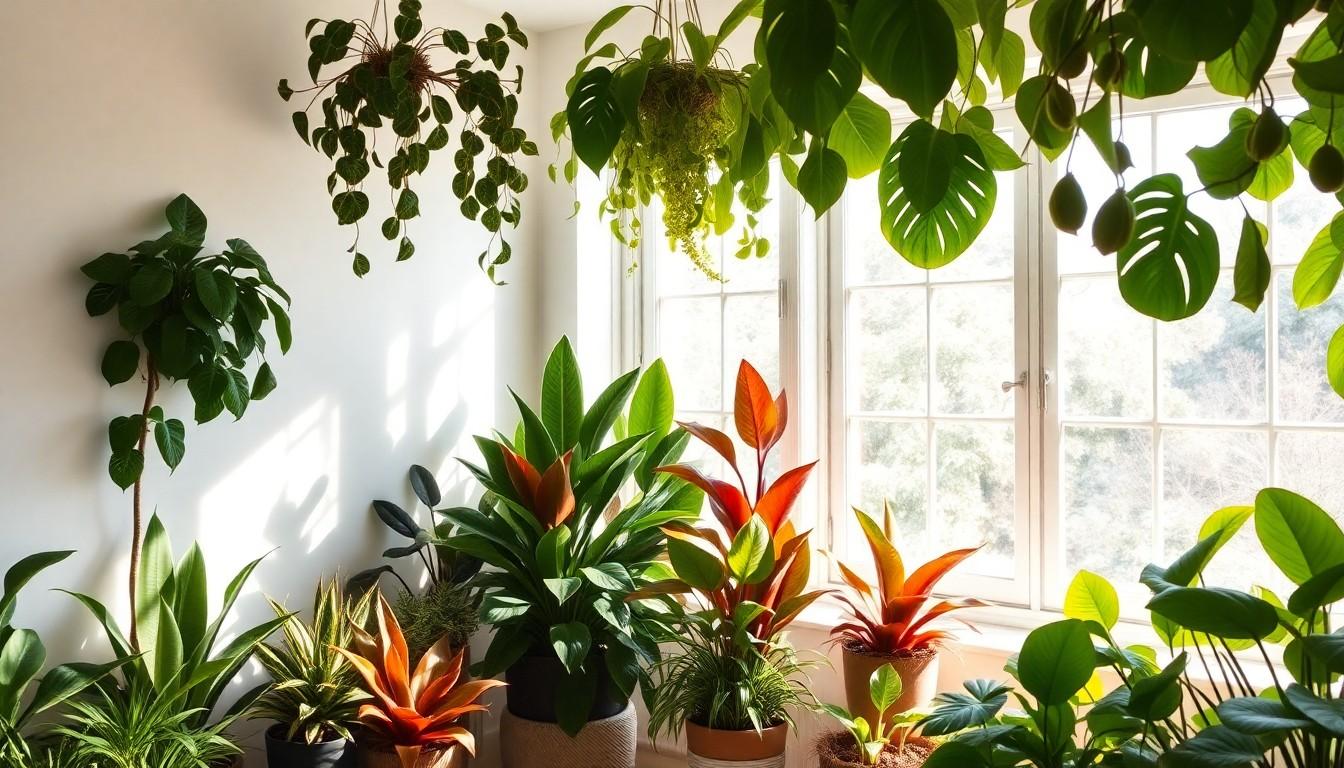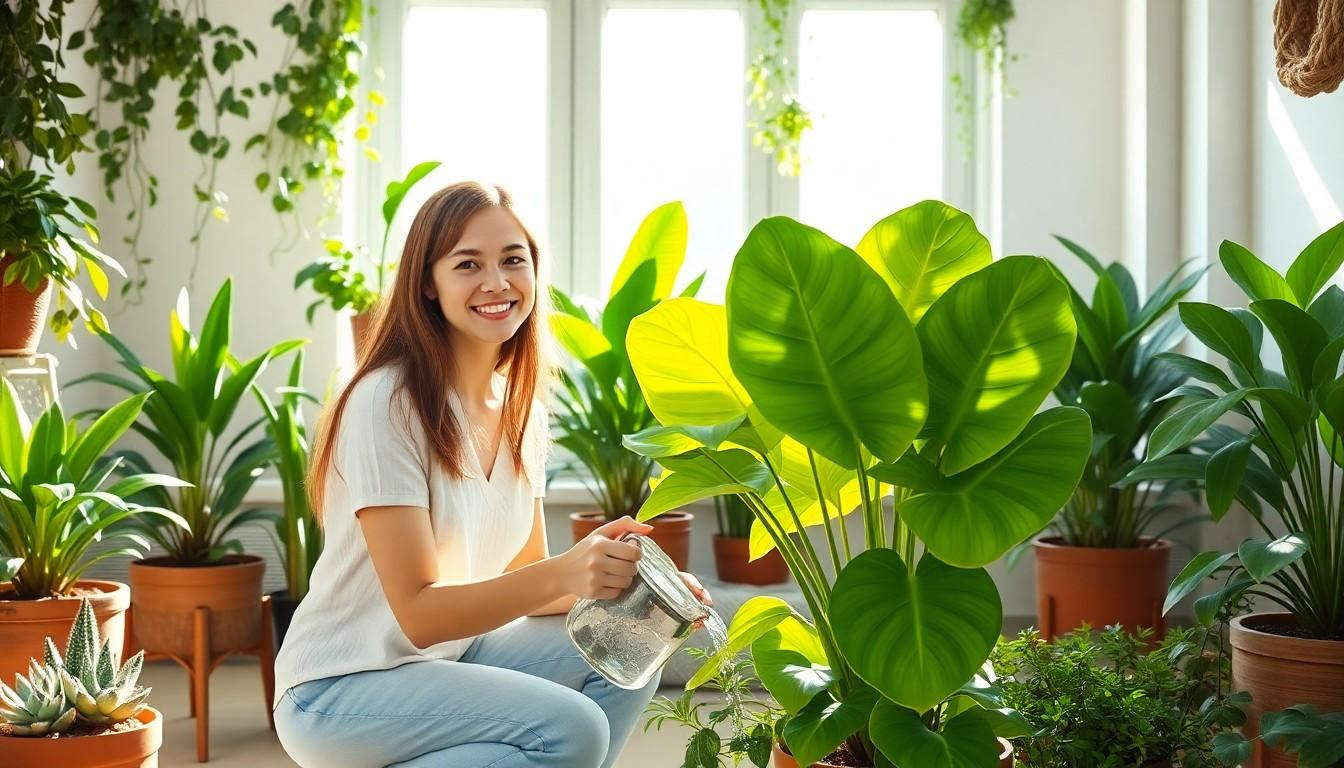A large south-facing window is like a VIP lounge for house plants, soaking up those glorious rays of sunshine. If you’re lucky enough to have one, it’s time to turn that sunny spot into a botanical paradise. But don’t just throw any old plant in there and hope for the best; not all plants are created equal when it comes to basking in bright light.
Benefits Of House Plants For A Large South Facing Window
House plants in a large south-facing window enhance indoor aesthetics significantly. These plants thrive in bright light, resulting in vibrant colors and lush growth. Improved air quality is another key benefit, as many house plants filter toxins and release oxygen.
Increased humidity levels occur naturally through transpiration, which supports overall comfort in the home environment. Plants such as succulents, orchids, and fiddle leaf figs thrive in bright light, offering a variety of textures and appearances.
Enhanced mood and productivity are also linked to having plants nearby. Studies show that being around greenery reduces stress and promotes well-being. Bright, natural light encourages healthy plant growth, leading to a lively atmosphere that can uplift spirits.
Also, a large south-facing window provides optimal conditions for growth, allowing plants to reach their full potential. Healthy, flourishing plants often lead to increased engagement in plant care, fostering a sense of responsibility and connection to nature.
With careful selection of appropriate species, individuals can turn their sunny spaces into lush retreats. Robust growth and strong vitality in house plants result from consistent, bright sunlight. Enjoying the visual delight and health benefits of these plants contributes to a more vibrant living space.
Best House Plants For South Facing Windows

Selecting the right house plants for a large south-facing window maximizes the benefits of abundant sunlight. Here are some excellent options to consider.
Sun-Loving Plants
Succulents thrive in direct sunlight, making them ideal for sunny windows. Examples include Echeveria and Haworthia, which tolerate heat and require minimal watering. Snake plants also excel in bright, sunny conditions. Their upright leaves add a modern touch to any space. Meanwhile, pothos benefits from bright light and can trail elegantly, creating striking displays. The vibrant leaves of rubber plants enhance visual interest while they soak up the sun’s rays.
Low-Maintenance Options
ZZ plants demand little care while flourishing in direct light. Their glossy leaves add a touch of elegance and adapt well to varied environments. Peace lilies not only endure bright conditions but also improve indoor air quality. Spider plants produce charming offsets that are simple to propagate. Additionally, cast iron plants exhibit robustness and thrive on neglect, making them perfect for beginners.
Unique Varieties To Consider
Bird of paradise brings a tropical flair to sunny spaces with its striking foliage and large leaves. Fiddle leaf figs, known for their dramatic appearance, thrive in bright light, creating a focal point. Consider a monstera as well, with its unique split leaves adding visual intrigue. For a touch of color, try croton, which showcases vibrant leaf patterns. Finally, the jade plant provides a succulent option with its round leaves and tree-like growth, further enhancing the beauty of a sun-filled window.
Care Tips For House Plants In Bright Light
House plants in bright light require specific care to thrive. Understanding their needs ensures health and vibrancy.
Watering Needs
Watering frequency varies among different plants. Succulents thrive with infrequent watering, while pothos prefer slightly moist soil. Check the top inch of the soil; if it’s dry, water your plants. Don’t let them sit in standing water; this fosters root rot. Consider using a watering schedule based on the plant’s specific needs and seasonal changes. Monitoring leaves provides clues; wilted leaves may indicate both under-watering and over-watering.
Soil and Potting Considerations
Soil quality plays a crucial role in the health of house plants. Use a well-draining potting mix suitable for each plant species; this prevents sogginess. Succulents and cacti thrive in sandy soil, whereas rubber plants prefer a rich, loamy mix. Repotting every 1 to 2 years promotes growth. Ensure pots have drainage holes to avoid water accumulation. Choosing pots slightly larger than the current one can give roots space to grow.
Pruning and Maintenance
Regular pruning maintains the health and appearance of house plants. Remove dead or yellowing leaves to encourage new growth. Fiddle leaf figs benefit from occasional shaping, promoting a bushier look. Dusting leaves aids photosynthesis and keeps plants healthy. Seasonal checks for pests ensure infestations do not escalate. Providing support for taller plants helps maintain structure as they grow. Adapt pruning techniques based on plant growth and specific needs for optimal results.
Decorating With House Plants
House plants transform spaces, adding life and vibrancy. Utilizing a large south-facing window creates a sunlit haven for greens.
Arranging Plants For Aesthetic Appeal
Arranging plants creatively enhances visual interest. Use varying heights, placing taller plants like fiddle leaf figs back and shorter varieties like pothos in front. Grouping plants in odd numbers creates a more organic look. Consider using plant stands or shelves to elevate some plants, adding layers to the display. Incorporating decorative pots complements the overall aesthetic. Ensure that foliage colors and textures contrast, bringing harmony to the arrangement. Regularly changing the arrangement keeps the look fresh and engaging.
Combining Different Plant Types
Combining different plant types adds depth to the decor. Mix leafy plants like snake plants with flowering varieties such as peace lilies for contrast. Selecting plants with similar care requirements simplifies maintenance. Textured leaves from plants like monstera can pair beautifully with the smooth, uniform leaves of succulents. Incorporating trailing plants like spider plants brings movement to the display. Play with colors and shapes to create focal points within the arrangement. Cultivating a diverse plant collection enhances the visual experience while promoting a thriving indoor ecosystem.
Conclusion
A large south-facing window offers an exceptional opportunity for house plants to thrive. By selecting the right plants and following care tips, individuals can create a vibrant indoor oasis that enhances both aesthetics and well-being. The interplay of light and greenery not only beautifies spaces but also contributes to improved air quality and mood.
With the right arrangement and a thoughtful mix of plant varieties, anyone can transform their sunny area into a lush retreat. Embracing this natural connection fosters a sense of responsibility and joy, making the journey of plant care a rewarding experience.

